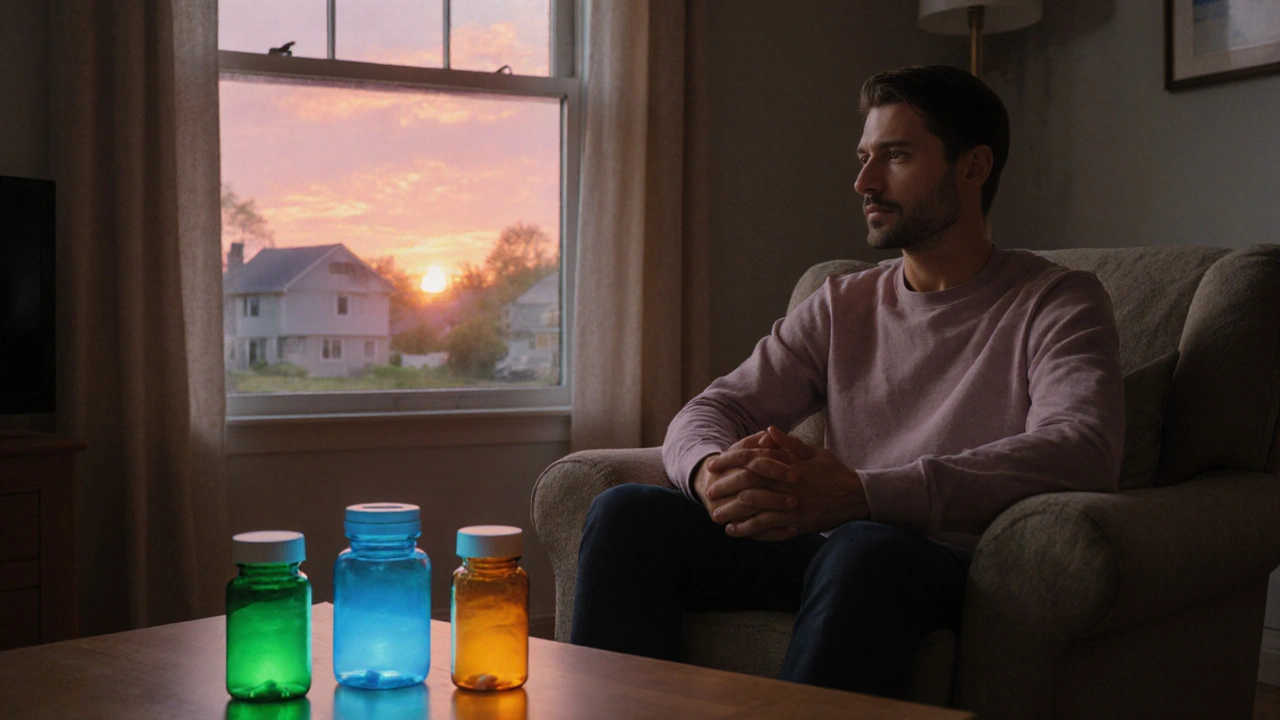28 Sep 2025
- 7 Comments
Anxiety Medication Decision Helper
Answer these questions to find the best anxiety medication for you:
Trying to decide whether Buspar is right for you or if another anxiety pill might work better? You’re not alone. Millions wrestle with generalized anxiety disorder (GAD) and the maze of prescription choices. This guide breaks down Buspar, how it stacks up against the most common alternatives, and which factors should drive your final decision.
Quick Takeaways
- Buspar is a non‑benzodiazepine anxiolytic with low abuse risk but a slower onset (1‑2 weeks).
- Fast‑acting benzodiazepines (e.g., alprazolam, lorazepam) work within hours but can cause dependence.
- SSRIs and SNRIs (e.g., sertraline, venlafaxine) are first‑line for chronic anxiety, requiring several weeks to become effective.
- Antihistamines like hydroxyzine provide short‑term relief without habit‑forming potential.
- Choosing the right drug hinges on symptom severity, lifestyle, comorbidities, and how quickly relief is needed.
What Is Buspar (Buspirone)?
Buspirone is a non‑benzodiazepine anxiolytic that acts primarily as a serotonin 5‑HT1A receptor partial agonist. It was approved by the FDA in 1986 for the treatment of generalized anxiety disorder.
Unlike benzodiazepines, Buspirone has virtually no muscle‑relaxant or anticonvulsant effects, which means you won’t feel sedated or drowsy in most cases. Its half‑life ranges from 2 to 3 hours, so it’s usually taken twice or three times daily.
How Buspar Works and Who It Helps Most
The 5‑HT1A partial agonism modulates serotonin pathways linked to anxiety regulation. Because it doesn’t enhance GABA activity, the risk of respiratory depression or severe withdrawal is minimal.
Best suited for patients who:
- Need a long‑term solution without the stigma of a controlled‑substance prescription.
- Can tolerate a gradual onset of action.
- Have a history of substance misuse or are on medications that interact poorly with benzodiazepines.
Common Side Effects of Buspar
Side effects are usually mild but can include:
- Dizziness or light‑headedness.
- Nausea or upset stomach.
- Headache.
- Restlessness (akathisia) in a small subset of patients.
These tend to fade after the first few weeks. Serious reactions like mood swings or suicidal thoughts are rare but warrant immediate medical attention.
Key Criteria for Comparing Anxiety Medications
When you line up Buspar against its rivals, focus on these five dimensions:
- Onset of relief - How quickly does the drug reduce anxiety symptoms?
- Abuse potential - Is the medication schedule‑controlled?
- Side‑effect profile - Does it cause sedation, weight gain, or cognitive fog?
- Drug‑interaction risk - How many other meds can it safely coexist with?
- Long‑term suitability - Is it recommended for chronic use?
Alternative #1: Alprazolam (Xanax)
Alprazolam is a short‑acting benzodiazepine that enhances GABA activity, producing rapid anxiolysis. It’s commonly prescribed for panic disorder and acute anxiety spikes.
Pros: Works within 30‑60 minutes, strong symptom control.
Cons: High abuse risk, tolerance develops in weeks, may cause daytime drowsiness and memory issues.
Alternative #2: Sertraline (Zoloft) - An SSRI
Sertraline belongs to the selective serotonin reuptake inhibitor (SSRI) class, boosting serotonin levels over time. It’s FDA‑approved for GAD, depression, and several other mood disorders.
Pros: Low abuse potential, evidence‑based for long‑term anxiety management, may improve co‑occurring depression.
Cons: Takes 4‑6 weeks for full effect, possible sexual dysfunction, gastrointestinal upset.

Alternative #3: Hydroxyzine - Antihistamine with Anxiolytic Effects
Hydroxyzine is a first‑generation antihistamine that also blocks central nervous system histamine receptors, providing calming effects. It’s often used for short‑term anxiety or as a sleep aid.
Pros: No controlled‑substance classification, works within an hour, can be taken as needed.
Cons: Causes noticeable sedation, anticholinergic side effects (dry mouth, constipation), not ideal for daily chronic use.
Alternative #4: Pregabalin (Lyrica) - Gabapentinoid
Pregabalin is a gabapentinoid that reduces excitatory neurotransmitter release, useful for generalized anxiety and neuropathic pain. It’s approved in many countries for GAD, though not in the U.S. for that indication.
Pros: Fast onset (within a week), helps with comorbid pain, low abuse potential.
Cons: Can cause dizziness, weight gain, edema; requires dose titration.
Alternative #5: Lorazepam (Ativan) - Longer‑Acting Benzodiazepine
Lorazepam is a mid‑duration benzodiazepine that provides anxiolysis and sedation. It’s often chosen for insomnia‑related anxiety or when a steadier plasma level is needed.
Pros: Strong calming effect, useful for breakthrough anxiety.
Cons: Same abuse and dependence concerns as other benzodiazepines, may cause residual sedation the next day.
Side‑by‑Side Comparison Table
| Medication | Drug Class | Typical Daily Dose | Onset of Relief | Half‑Life | Abuse Potential | FDA‑Approved for GAD |
|---|---|---|---|---|---|---|
| Buspirone | 5‑HT1A Partial Agonist | 5-30 mg (split 2‑3×/day) | 1-2 weeks | 2-3 hrs | Low | Yes |
| Alprazolam | Benzodiazepine | 0.25-4 mg (as needed) | 30‑60 mins | 11-16 hrs | High | No (panic disorder) |
| Sertraline | SSRI | 25-200 mg | 4‑6 weeks | 26 hrs | Very Low | Yes |
| Hydroxyzine | First‑gen Antihistamine | 25-100 mg (prn) | 1‑2 hrs | 20‑25 hrs | None | No (off‑label) |
| Pregabalin | Gabapentinoid | 150-600 mg | 1‑2 weeks | 6‑7 hrs | Low | Not in US |
| Lorazepam | Benzodiazepine | 1-4 mg (as needed) | 30‑60 mins | 12‑18 hrs | High | No (anxiety off‑label) |
Decision Guide: Which Medication Fits Your Lifestyle?
Use the following flow to narrow down the best choice:
- If you need rapid relief for a panic episode, a benzodiazepine like alprazolam or lorazepam is the most effective.
- If you want non‑controlled, daily use and can wait 1‑2 weeks, Buspirone or pregabalin are solid picks.
- If you also battle depression or OCD, an SSRI such as sertraline usually covers both conditions.
- For occasional anxiety that interferes with sleep, consider hydroxyzine as a PRN option.
- When you have a history of substance misuse, avoid benzodiazepines entirely and lean toward Buspirone, SSRIs, or pregabalin.
Always discuss dosage adjustments and taper plans with your prescriber-especially for any drug with dependence potential.
Checklist Before Starting a New Anxiety Medication
- Confirm diagnosis (e.g., Generalized Anxiety Disorder).
- Review current meds for interactions (especially with MAO inhibitors, CYP450 substrates).
- Assess liver and kidney function if the drug is metabolized hepatically.
- Discuss lifestyle factors: night‑shift work, need for alertness, driving, or operating machinery.
- Plan a follow‑up visit within 2-4 weeks to evaluate efficacy and side effects.
Potential Pitfalls & How to Avoid Them
Skipping the titration period. Jumping straight to a high dose of Buspirone or an SSRI can trigger nausea, dizziness, or intensified anxiety. Start low, increase gradually.
Mixing benzodiazepines with alcohol. Even a single drink can dangerously amplify sedation and respiratory depression.
Stopping abruptly. Discontinuing benzodiazepines or gabapentinoids too fast can cause rebound anxiety or seizures. Taper under medical supervision.
Bottom Line: Match the Drug to the Need
There’s no one‑size‑fits‑all answer. Buspirone shines for patients who value a non‑addictive, daily pill and can be patient with its gradual onset. Benzodiazepines dominate when speed trumps long‑term safety. SSRIs dominate the chronic‑use arena, especially with comorbid mood disorders. Antihistamines and gabapentinoids fill niche roles for short‑term or pain‑related anxiety.
Talk openly with your healthcare provider, weigh the pros and cons laid out here, and pick the medication that aligns with your health goals and daily routine.

Frequently Asked Questions
Can I take Buspirone and an SSRI together?
Yes, many clinicians combine Buspirone with an SSRI to boost anxiety control while minimizing side effects. The two drugs work on different pathways, so they don’t usually interact negatively. However, start at low doses and monitor for increased serotonin syndrome signs.
How long does it take for Buspirone to start working?
Most patients notice a modest reduction in anxiety after about one week, but the full therapeutic effect often appears after 2‑3 weeks of consistent dosing.
Is Buspirone safe during pregnancy?
Animal studies haven’t shown major risks, but human data are limited. It’s classified as CategoryC, meaning risk can’t be ruled out. Discuss alternatives with your OB‑GYN before starting.
What should I do if I miss a Buspirone dose?
Take the missed dose as soon as you remember, unless it’s almost time for the next dose. In that case, skip the missed one-don’t double‑dose.
Can I stop taking Buspirone abruptly?
Unlike benzodiazepines, Buspirone doesn’t cause severe withdrawal, but stopping suddenly can lead to a rebound of anxiety. It’s best to taper down under doctor supervision.


Meigan Chiu
September 29, 2025While most guides tout Buspirone as a harmless alternative, the pharmacology warrants caution. Its partial agonism at 5‑HT1A receptors can paradoxically heighten anxiety in the initial weeks if the titration is too aggressive. Moreover, the claim that it “doesn’t cause sedation” overlooks the documented dizziness and light‑headedness that impair daily tasks. Patients should therefore monitor their response closely and consult their prescriber before assuming safety.
Patricia Hicks
September 29, 2025Choosing the right anxiety medication is like picking the perfect pair of shoes – comfort, fit, and style all matter.
Buspirone shines for those who prefer a steady, non‑addictive companion on their mental health journey.
Its gradual onset teaches patience, which can be a hidden therapeutic benefit in itself.
When you pair it with regular therapy or mindfulness practices, the combined effect often exceeds the sum of its parts.
Moreover, the low abuse potential means you won’t have to worry about the stigma that sometimes follows controlled‑substance prescriptions.
For individuals juggling work, family, or studies, the twice‑daily dosing fits neatly into most daily routines.
If you’ve experienced drowsiness from other meds, you’ll appreciate that Buspirone usually leaves you alert and able to focus.
Side effects such as mild dizziness typically fade after the first couple of weeks, allowing you to maintain productivity.
Should you encounter persistent nausea, a simple food‑based adjustment-taking the pill with a snack-often resolves the issue.
In cases where anxiety co‑exists with depression, adding an SSRI can amplify relief without compromising safety.
Remember that any medication works best when you keep open communication with your prescriber, reporting both wins and setbacks.
Titrating the dose slowly, starting at 5 mg and increasing as tolerated, reduces the chance of early‑stage discomfort.
The flexibility of dose adjustments makes Buspirone adaptable to life’s inevitable changes, whether that’s a new job or a shift in sleep patterns.
While some may dismiss its “slow” label, consider that lasting change often requires time, unlike the fleeting high of a benzodiazepine.
Ultimately, the decision rests on your personal health goals, risk tolerance, and lifestyle priorities.
Embrace the process, stay patient, and you’ll likely find a balance that supports both your mental wellness and everyday ambitions.
Quiana Huff
September 29, 2025🚀 Let’s talk neurochemistry: Buspirone’s 5‑HT1A partial agonism modulates the limbic circuitry, which is pretty cool for sustained anxiolysis 😊. If you’re into psychopharmacology, you’ll love how the drug’s half‑life permits stable plasma concentrations without the peaks that cause jittery side‑effects. Pair it with CBT and you’ll see synergistic neuroplastic adaptations-think of it as software + hardware upgrades for your brain. Stay consistent with dosing; the pharmacokinetic profile rewards adherence. Keep an eye on those early‑stage vestibular vibes, they usually settle by week two.
William Nonnemacher
September 29, 2025Buspirone’s delayed onset makes it a poor choice for acute panic attacks.
Alex Ramos
September 29, 2025Listen, the data is crystal clear: if you want a medication with a rapid onset, you must consider a benzodiazepine-however, the risk of dependence, the regulatory hurdles, and the potential for cognitive dulling are non‑negotiable! That said, Buspirone offers a viable non‑controlled alternative, provided you can tolerate the 1‑2‑week lag time, and you’re willing to engage in dose titration, which, frankly, is a small price to pay for safety! Remember, every therapeutic decision should be individualized, not a one‑size‑fits‑all prescription!
Mita Son
September 30, 2025Ok, so here’s the sitch-Buspirone ain’t some magic pill, but it does its job if you give it time, got it? Some folks think the dizziness is a deal‑breaker, but honestly it’s just a tiny hiccup that fades. And yeah, the spelling might be off in some forums, but the science stays solid.
ariel javier
September 30, 2025From a clinical standpoint, the proposition that Buspirone supersedes benzodiazepines for all patients is fundamentally flawed. While its low abuse potential is commendable, the delayed therapeutic onset precludes its utility in emergent anxiety crises. Moreover, a blanket recommendation disregards individual pharmacogenomic variability, which can markedly affect efficacy. Physicians must therefore conduct a nuanced risk‑benefit analysis rather than default to a one‑dimensional algorithm. In sum, prescribing practices should reflect both the pharmacodynamic profile and the patient’s immediate clinical needs.